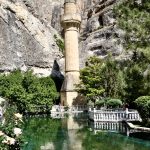Turkey’s apricot capital Population: 485,500
Old names: Melid (Assyrian), Melitene (Greco-Roman)
Market day: Friday (beside Kernek Cami), Sunday (near Malatya Park AVM)
Apricot harvest: July
Favourite sons: İsmet İnönü, Turgut Özal
***Malatya was one of the towns worst affected by the twin earthquakes of 2023. What is written here may therefore be historical.***
Malatya is a town that has come a long way in the last 25 years. Like Gaziantep, it was one of those places on the fringe of the south-east that swelled rapidly as people moved west to distance themselves from the Kurdish troubles. Today it’s a bit of a boom town with apricots just one of the commodities helping it pay its way.
It’s a town with a link to two political heavy-weights. İsmet İnönü (1884-1973), friend, colleague and successor to Mustafa Kemal Atatürk as the second president of the Republic, was born in İzmir to a family that came originally from Malatya, while Turgut Özal (1927-93) was born here and went on to become the eighth president of Turkey. Less happily, Malatya (or rather the nearby village of Hekimhan) was birthplace in 1958 to Mehmet Ali Ağca, the man who shot Pope John Paul II (as well as Milliyet editor Abdi İpekçi) and whose story is detailed in Witold Szablowski’s book, The Assassin from Apricot City.
The fame of its apricots not withstanding, most tourists who come here do so in the hope of visiting the great Commagenian heads on the summit of Nemrut Dağı (Mt Nemrut). The more usual approach is from Adiyaman or Kahta. However, there is also a road that travels south from Malatya if you can get together enough people to cover the cost of transport on a less popular route.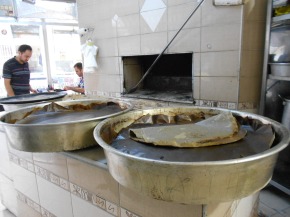 Making kağıt kebabı
Making kağıt kebabı
It’s in Malatya that you start to see signs that you’ve reached eastern Turkey. Some of the older men here still walk around in baggy şalvar pants with matching waistcoats – Yeşilyurt residents favour an attractive suit of şalvar, waistcoat and skullcap in fern-grey. Most of the restaurants and tea gardens offer separate sections for women and families (aile) although you’re not obliged to use them. This does not apply to the trendy cafes of Kanalboyu Caddesi where men and women sit together perfectly naturally. In 2017 pink female-only buses were introduced to the town – I don’t know if they are still operating.
Don’t leave town without trying:
- kağıt kebabı (paper kebab), a lamb stew cooked overnight inside a packet of oiled paper so that the meat comes out melt-in-the-mouth tender
- çikolatılı kayısı (chocolate apricots) – go on, spoil yourself!
Backstory
To understand why there is so little that is obviously old in Malatya you need to realise that it’s a town that has moved around over history. The oldest known settlement in the area was at Aslantepe Höyügü in the village of Orduzu. The Romans abandoned that site in favour of nearby Battalgazi (Eski Malatya) which was, in turn, sidelined in favour of modern Malatya.
As the story goes, people had been living in what is now Battalgazi for many centuries until 1838-39 when regiments of the Ottoman army took up residence and local families fled south to protect the honour of their wives and daughters. As the new Malatya grew, so the older settlement shrunk. Now it’s in Battalgazi that you’ll find all the historic structures that Malatya itself lacks.
Around town
The good news in what can look at first like a rather overwhelming modern city is that virtually everything you will want to see fits inside a small square in the centre.
Perhaps the most conspicuous landmark in the town centre was the large and elegant if hardly old Yeni Cami (New Mosque). Although it only dated back to 1912-13 from the rear it looked remarkably similar in design to some of the Byzantine churches in İstanbul. It’s position right behind the Şire Pazarı (bazaar area) meant that it was usually busy at all times of day. Unfortunately, in 2023 an earthquake brought down the dome of the mosque. It will probably be many years before it is rebuilt.
In front of the mosque are the narrow streets and covered areas of the bazaar. It’s well worth spending some time poking about here whether to admire the mountains of fresh fruit and vegetables, to recoil in horror from the piles of heads and hooves being cooked in the metalworkers’ area or to take your pick of the apricot gift baskets on sale in the Kayısı Hanı (Apricot Han) between the rest of the bazaar and the Çevre Yolu (Ring Road). Well worth finding is the corner where men spend their days preparing künefe, kadayıf and yassı kadayıf on huge metal griddles.
Behind the mosque is busy İnönü Caddesi, the main drag. On the far side is the bleak Vilayet building with a huge statue of İnönü in front of it. 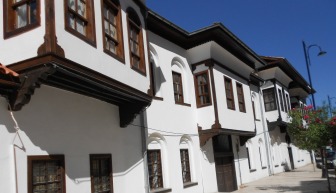
If you head south down Fuzuli Caddesi and then turn left along Sinema Caddesi you will come to some of the few old Ottoman houses to survive in Malatya. Most have been restored and the Beşkonaklar, a group of five linked mansions once owned by one family, house the tourist information office, a small ethnographic museum, the offices of the environmental organization ÇEKÜL, and the Malatya Mutfağı restaurant. The contents of the museum are of only passing interest but a visit gives you a chance to inspect the plastered niches and wooden fittings that typically graced mansions like this.
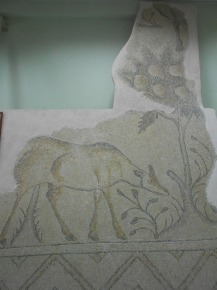 Mosaic from near DoğanşehirFuzuli Caddesi ends at the Kernek Meydanı which is dominated by a big modern mosque. Behind it is the local Archaeological Museum (closed Mondays) which should really be called the Aslantepe Museum since the majority of its contents are the minor finds from the nearby site (Ankara Archaeological Museum scooped the major Hittite items) including some impressive photographs of the earliest excavations. Other finds come from sites drowned after the building of the Karakaya Barajı (dam). Oddly, the landscaping in front of the museum incorporates an Amsterdam-style wooden windmill.
Mosaic from near DoğanşehirFuzuli Caddesi ends at the Kernek Meydanı which is dominated by a big modern mosque. Behind it is the local Archaeological Museum (closed Mondays) which should really be called the Aslantepe Museum since the majority of its contents are the minor finds from the nearby site (Ankara Archaeological Museum scooped the major Hittite items) including some impressive photographs of the earliest excavations. Other finds come from sites drowned after the building of the Karakaya Barajı (dam). Oddly, the landscaping in front of the museum incorporates an Amsterdam-style wooden windmill.
Heading east of Kernek Meydanı is lovely plane-tree-shaded Kanalboyu Caddesi with the eponymous canal running down the middle and cafes on either side of the street. At the junction with Atatürk Caddesi you’ll come to a cluster of early 20th-century stone buildings, including the Atatürk Evi (closed Mondays) in a Halkevi (Community Centre) visited by Atatürk. It’s open to the public although foreign visitors are unlikely to be particularly excited by the standard collection of photographs of the great leader.
Overlooking the junction is a strange statue of Atatürk with his arm around a naked man. Beside it the İsmet Paşa Parkı is full of cafes and tea gardens.
 With time to spare, you might want to venture across the Çevre Yolu (Ring Road) to the Çavuşoğlu neighbourhood where the huge and austere 19th-century Armenian Taşhoron Church has been restored. It is surmounted by an impressive central dome that has lost its roof, and the doors and windows are still marked with simple crosses. If you keep your eyes peeled you’ll spot it on the right as you head back to the MAŞTİ bus terminal.
With time to spare, you might want to venture across the Çevre Yolu (Ring Road) to the Çavuşoğlu neighbourhood where the huge and austere 19th-century Armenian Taşhoron Church has been restored. It is surmounted by an impressive central dome that has lost its roof, and the doors and windows are still marked with simple crosses. If you keep your eyes peeled you’ll spot it on the right as you head back to the MAŞTİ bus terminal.
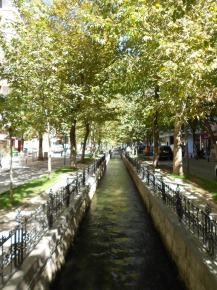 Kanalboyu Caddesi is lined with cafesEating and drinking
Kanalboyu Caddesi is lined with cafesEating and drinking
There are lots of small lokantas to serve the workers in the side streets of the bazaar and they make good places to pick up a cheap and nourishing meal, especially if you want to try out kağıt kebabı. For something a little more formal the Malatya Mutfağı in the Beşkonaklar with an inviting back garden in Sinema Caddesi is a good choice. Note that zırh kebabı is a local name for şiş kebabı.
Fusion foods such as pasta dishes and salads rule the roost in the cafes of Kanalboyu Caddesi which are very popular with the town’s large student population.
Of the many tea gardens my favourite is the Gazi Aile Çay Bahçesi which offers fountains and ducks to entertain its customers.
Sleeping
Malatya has lots of hotels to suit business travellers although nothing remotely interesting in terms of architecture. The brand-name hotels tend to be furthest from the centre but are probably most reliable when it comes to the comforts.
The Büyük Hotel, where I had stayed many times, was destroyed in the earthquake.
Anemon. Tel: 0422-238 1818
Double Tree by Hilton
Grand Akkoza Hotel. Tel: 0422-326 2727
Hotel Altın Kayısı. Tel: 0422-211 4444
Ramada Plaza Altın Kayısı. Tel: 0422-211 4444
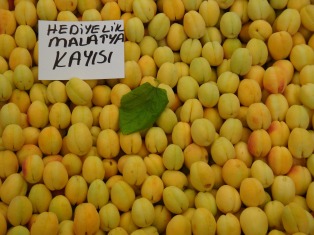 Shopping
Shopping
Malatya is famous all over Turkey for its apricots and competition is hot to persuade you to invest in a basket of dried apricots or in apricot-flavoured pestil (“fruit leather”) or even apricot döner (döner-kebab-shaped wedges of dried apricots). If you don’t have time to shop, never fear as the bus station has plenty more apricots for sale.
More of an acquired taste is köpüklü pestili, a variation on the “fruit leather” sold in other parts of Turkey. What look like sheets of folded paper turn out to have been made from pekmez (grape molasses), flour and limonlu tozu (lemon salt), actually shreds from the rind of a lemon.
Transport info
There are regular flights from İstanbul and Ankara to Malatya, and buses from Kayseri, Sivas and Elazığ.
There are also train services from İstanbul, Ankara and Diyarbakır.
The big MAŞTİ bus terminal is west of town but not too far west. On arrival in Malatya there is no servis bus into town. Come out of the front of the otogar, cross the busy main road in front and pick up a minibus or the trambus from in front of the mosque into the centre.
If you’re staying in Cappadocia note that there is one daily bus from Kayseri to Malatya at 2.30pm.
Buses to Darende via Balaban depart from Malatya’s shabby Köy Garaj on the eastern side of town behind a Petrol Ofisi garage; to get there take a minibus from behind the market in front of the Kırçuval Hotel.
Buses and dolmuşes to Orduzu and Battalgazi leave from the Çevre Yolu (Ring Road) at Akpınar. A new trambus service should have started service but may not have survived the earthquake.
The Battalgazi dolmuşes continue to the Karakaya Baraj to connect with ferry crossings for passengers heading for Elazığ via Baskıl. This is a longer and more costly way to get to Elazığ than by the direct bus but potentially much more fun. There are only a few ferry crossings daily so check before setting out.
Birlik dolmuşes to Elazığ and Diyarbakır were leaving from a private terminal to the east of the city in autumn 2013. They probably leave from the new Doğu Garajı (Eastern Terminal) now.
One dolmuş a day connects Malatya with Kemaliye though where it leaves from seems to vary from day to day.
Buses to Arapgir have their own terminal which I have never managed to track down..
Day trip destinations
Arapgir
Read more about local soup: http://turkeyfromtheinside.com/blogbloggingaboutturkey/entry/88-on-the-soup-trail-in-malatya.html
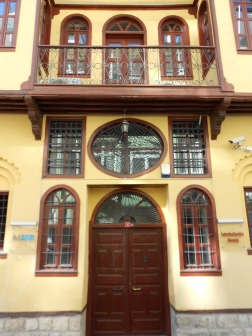 Restored İstanbulluoğlu Konağı
Restored İstanbulluoğlu Konağı


